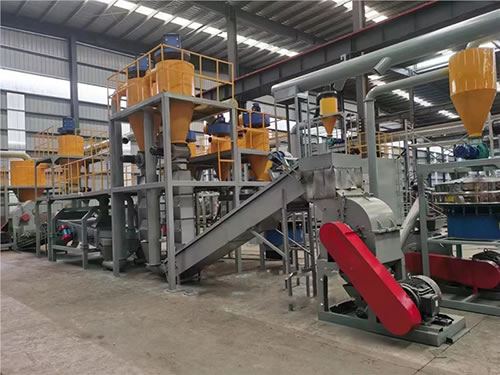Maoxin Machinery's lithium phosphate battery recycling and processing equipment has made a significant contribution to Singapore's environmental protection efforts
Singapore is an island country located at the southern tip of the Malay Peninsula, at the entrance and exit of the Strait of Malacca. It is adjacent to Malaysia in the north and faces Indonesia across the Singapore Strait in the south. Singapore has a total area of about 728.6 square kilometers, including 63 small islands around the main island.
The history of Singapore can be traced back to the 3rd century when there were indigenous inhabitants. The earliest literature record comes from "Wu Shi Wai Guo Zhuan" written by Kang Tai, a general of Eastern Wu in the 3rd century. According to research by Xu Yunqiao, a scholar in Singapore, "Puluo Zhong" is the transliteration of "Pulau Ujong" in Malay, which means "island at the end of the peninsula".

The environmental standards for the recycling and processing of lithium iron phosphate batteries are mainly reflected in several aspects:
1. **Overall Management Requirements**:
- The entire process from dismantling, sorting, crushing, and sieving to comprehensive utilization and disposal must comply with relevant national environmental protection laws, regulations, and standards.
- Enterprises need to establish a comprehensive environmental management system to ensure that all links in the recycling process meet environmental requirements and minimize the impact on the environment.
2. **Dismantling and Sorting Requirements**:
- During the dismantling process, operations must be carried out in a closed environment equipped with efficient fume collection and treatment devices to prevent the leakage of harmful gases such as hydrogen fluoride and dust.
- After dismantling, components such as the cathode, anode, diaphragm, and electrolyte must be effectively sorted and collected to facilitate subsequent treatment and recovery.
3. **Crushing and Sieving Requirements**:
- When crushing and sieving the electrode materials, appropriate dust removal equipment must be used to control dust emissions and reduce air pollution.
- Noise pollution should also be controlled during the crushing process by taking sound insulation measures or choosing low-noise equipment.
4. **Comprehensive Utilization and Disposal Requirements**:
- For the recovered metals such as lithium, cobalt, nickel, etc., the purity must meet relevant standards to ensure their quality and safety during reuse.
- Wastewater and waste gas generated during the recovery process must be treated to meet discharge standards before being discharged. For example, wastewater containing heavy metals needs to undergo processes such as chemical precipitation, ion exchange, and membrane separation to remove harmful substances; waste gas containing fluorine compounds and organic matter needs to be treated through adsorption, catalytic oxidation, and other methods.
- The treatment and disposal of solid waste such as waste residue and filter cake must comply with relevant regulations to avoid secondary pollution.
In summary, the environmental standards for the recycling and processing of lithium iron phosphate batteries aim to achieve resource recovery while minimizing environmental pollution through requirements for overall management, dismantling and sorting, crushing and sieving, and comprehensive utilization and disposal. These standards provide an important basis for standardizing the recycling industry and promoting its green development.

# Full Process Technology Analysis of Lithium Iron Phosphate Battery Recycling and Treatment Equipment
Lithium iron phosphate battery recycling and treatment equipment play a crucial role in the sustainable management of batteries. The whole process begins with collection, where used batteries are gathered from various sources such as electric vehicles and energy storage systems.
The first step is discharging, ensuring the batteries are safe to handle by eliminating residual electricity. Then comes dismantling, separating the battery cells from the battery pack carefully to avoid damage.
Next is the crushing stage, which breaks the battery materials into smaller pieces to facilitate the subsequent processes. After that, physical separation techniques like magnetic separation and gravity separation are employed to remove metal impurities.
Chemical treatment follows, involving leaching and precipitation to extract valuable metals like lithium, iron, and phosphorus. Finally, the recovered materials can be purified and reused in the production of new batteries or other industrial applications. This full - process technology not only reduces environmental pollution but also conserves valuable resources.
Generally speaking, with the continuous development of Singapore's economy and the acceleration of its industrialization process, the demand for recycling and processing equipment for lithium iron phosphate batteries by enterprises in the secondary recycling industry is constantly increasing. As an important type of secondary recycling equipment, the market demand for lithium iron phosphate battery recycling and processing equipment is also growing accordingly. In the future, with the advancement of technology and the improvement of environmental protection requirements, the research, development and application of lithium iron phosphate battery recycling and processing equipment will become more extensive and in-depth, making a greater contribution to promoting industrial development in Singapore and even nationwide. Maoxin Machinery wishes customers of lithium iron phosphate battery recycling and processing equipment in Singapore: in the days to come, we are grateful for your presence and our seamless cooperation. Let us work together for the development of our enterprise. May our enterprise prosper continuously, and let us send each other the warmest blessings. May our partners have everything go smoothly.